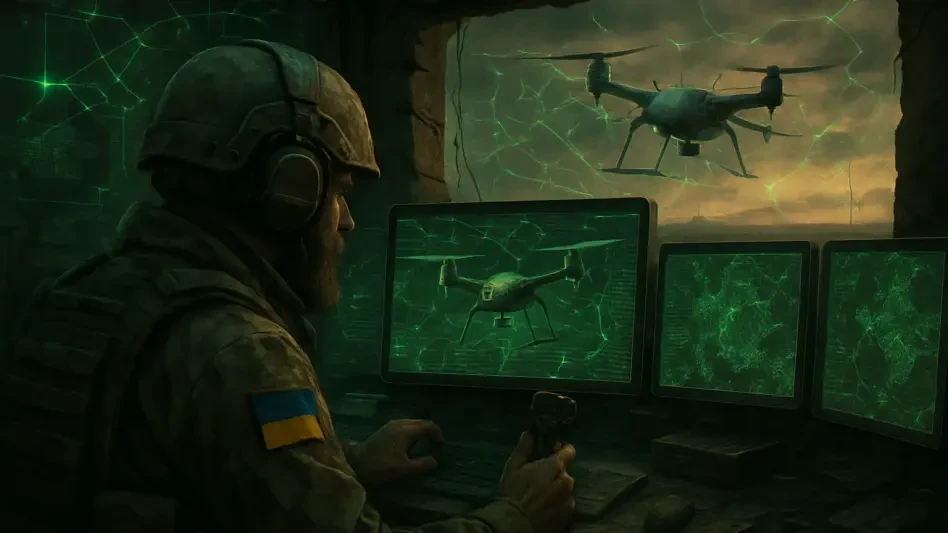The ongoing conflict in Ukraine has transformed the nation into a crucible of modern warfare, where the lines between traditional combat and cutting-edge technology blur in unprecedented ways, creating a landscape that challenges conventional notions of battle. Far beyond the imagery of soldiers and artillery, this war unfolds as a proving ground for privatized military operations, advanced drone systems, and relentless cyber assaults orchestrated by shadowy private entities. Ukraine stands as a stark preview of what future conflicts may entail—a battleground where commercial interests intertwine with geopolitical stakes, and where innovation in warfare is driven as much by profit as by necessity. This dynamic raises critical questions about accountability, oversight, and the evolving nature of global security. What unfolds in this Eastern European theater is not just a regional struggle, but a blueprint for how wars might be fought in the decades ahead, with private actors wielding influence once reserved for state militaries.
The Privatization of Modern Conflict
The Evolution of Private Military and Security Companies
The journey of private military and security companies (PMSCs) from mere manpower suppliers in the 1990s to today’s sophisticated system integrators reflects a profound shift in the landscape of warfare. With global military expenditure reaching a staggering $2.718 trillion in 2024, these entities have expanded their offerings far beyond hired guards or logistical support. Now, they provide integrated solutions that include cutting-edge drones, electronic warfare capabilities, and vast data management services. This evolution positions PMSCs not just as contractors, but as pivotal players on the battlefield, often operating with a level of autonomy that challenges traditional military hierarchies. In Ukraine, their role is particularly pronounced, as they supply both the tools and the expertise needed to navigate a complex, technology-driven conflict, effectively blurring the distinction between hired help and active combatants in the eyes of both allies and adversaries.
This transformation also signals a deeper commercialization of conflict, where PMSCs act as brokers of advanced systems rather than just personnel. Their ability to deliver comprehensive warfare packages—combining hardware, software, and strategic insight—has made them indispensable to state actors facing resource constraints or seeking deniability. In Ukraine, these companies have capitalized on the urgent demand for innovative solutions, embedding themselves into the fabric of military operations. The implications are vast, as their growing influence raises concerns about dependency, where nations may rely more on private entities than on their own forces. This trend, driven by record-breaking defense budgets, suggests a future where the privatization of war could redefine national security strategies, with private firms holding sway over critical aspects of defense that were once the sole domain of governments.
Cyber Mercenaries and Digital Warfare
In parallel with the rise of PMSCs, cyber mercenaries—often referred to as Private Sector Offensive Actors (PSOAs)—have emerged as formidable forces in Ukraine’s digital battleground. Operating in a murky space between state sponsorship and commercial profit, groups like Killnet and Ukraine’s IT Army deploy sophisticated tools such as malware, intrusion software, and Distributed Denial of Service (DDoS) attacks. Their actions disrupt critical infrastructure and sow chaos, often without clear attribution to any single entity. This ambiguity complicates efforts to establish accountability, as it remains unclear whether these actors operate under government directives, ideological motivations, or purely financial incentives. The digital front in Ukraine thus exemplifies a new kind of warfare, where unseen operatives wield as much power as physical forces on the ground.
The risks posed by cyber mercenaries extend beyond immediate battlefield impacts to broader concerns about escalation and oversight. Their ability to execute phishing campaigns and deploy spyware with little regulation creates vulnerabilities that can spill over into civilian domains, affecting global cybersecurity. In Ukraine, the overlap between state interests and private agendas further muddies the waters, as tacit approvals or funding from governments enable these actors to operate with impunity. This lack of clear governance frameworks heightens the danger of unintended consequences, where a single cyber operation could trigger retaliatory actions far beyond the intended scope. As digital warfare becomes a staple of modern conflict, the unchecked autonomy of these mercenaries poses a significant challenge to establishing norms and safeguards in an increasingly interconnected world.
Ukraine as a Testing Ground for Innovation
A Live Lab for Defense Technology
Ukraine’s emergence as the world’s foremost testing ground for defense technology underscores the unprecedented convergence of war and innovation. With defense investments skyrocketing by 500% to $5.2 billion in 2024, and over 80 start-ups now active in the region, the country has become a veritable “live lab” for refining cutting-edge tools under real combat conditions. Technologies such as AI-driven strike kits and kamikaze drones are not just conceptualized but actively iterated on the battlefield, often with direct input from private actors supported by state funding or procurement agreements. This rapid development cycle allows for immediate feedback and adaptation, pushing the boundaries of what military tech can achieve while simultaneously exposing gaps in ethical and regulatory oversight that struggle to keep pace with such advancements.
The synergy between state needs and private agility in Ukraine creates a unique ecosystem where innovation thrives amid chaos. Defense start-ups, many founded by veterans or tech entrepreneurs, collaborate closely with military units to tailor solutions like electronic warfare systems to specific tactical demands. However, this “live lab” dynamic often prioritizes speed over scrutiny, sidelining critical questions about the long-term implications of deploying untested technologies in active conflict zones. The involvement of high-profile ventures, such as Eric Schmidt’s White Stork AI-drone project, highlights the scale of private investment and interest, but also amplifies concerns about accountability. As these tools are normalized in Ukraine, their proliferation to other theaters of war becomes a looming possibility, potentially reshaping global military engagements in ways that are difficult to predict or control.
The Commercial Incentive of Prolonged Conflict
Prolonged conflict in Ukraine has given rise to a troubling commercial engine, where the duration of war directly correlates with the value of testing opportunities and data accumulation. The longer hostilities persist, the more extensive the datasets become, offering private actors unparalleled chances to refine technologies like autonomous drones and advanced surveillance systems. This creates a perverse incentive where extended warfare translates into enhanced business prospects for defense contractors and tech firms. Ukraine serves as a stark example of this dynamic, where the sustained intensity of the conflict has turned battlefields into lucrative proving grounds, positioning private entities not just as service providers but as key architects of modern warfare strategies that prioritize iterative innovation.
This commercial logic also reshapes the very nature of conflict management, with private actors increasingly controlling critical systems and platforms that influence outcomes on the ground. In Ukraine, the blending of state imperatives with market-driven agility has birthed a hybrid model where companies wield influence over both tactical decisions and long-term technological trajectories. The implications are profound, as the data and insights gained from such prolonged engagements become proprietary assets, further entrenching the power of private players in future conflicts. Skyeton’s Raybird, a drone system honed in real-time combat, exemplifies how quickly these innovations can scale, but also underscores the risk of a feedback loop where war becomes a self-sustaining industry. As this model takes hold, the challenge lies in balancing the undeniable benefits of rapid technological advancement against the ethical and strategic costs of a war economy driven by profit.
Reflecting on a Commercialized Battlefield
Looking back, the conflict in Ukraine revealed a sobering reality where warfare had morphed into a commercial enterprise, with private contractors and cyber mercenaries playing pivotal roles in shaping outcomes. The nation stood as both a battleground and a marketplace, having driven remarkable strides in drone technology, AI applications, and cyber operations, all while exposing critical gaps in oversight and responsibility. Moving forward, the global community must prioritize the development of robust frameworks to govern the actions of private actors in conflict zones, ensuring that innovation does not outstrip accountability. Establishing clear legal and ethical guidelines for the use of advanced technologies, alongside international cooperation to monitor cyber activities, offers a path to mitigate risks. Ukraine’s experience serves as a call to action, urging stakeholders to address how the privatization of war could be managed to prevent unchecked escalation and safeguard future stability in an era of hybridized conflict.








